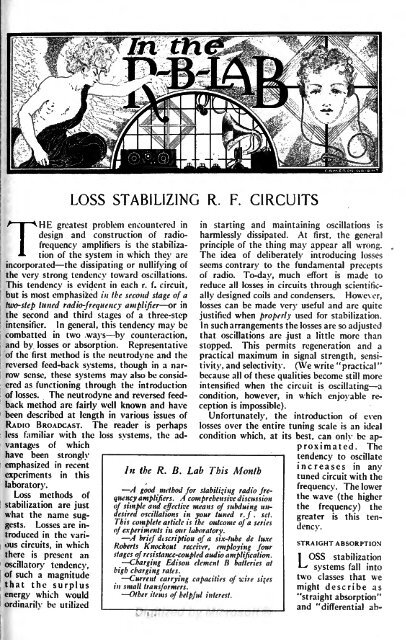Radio Broadcast - 1925, February - 113 Pages ... - VacuumTubeEra
Radio Broadcast - 1925, February - 113 Pages ... - VacuumTubeEra
Radio Broadcast - 1925, February - 113 Pages ... - VacuumTubeEra
You also want an ePaper? Increase the reach of your titles
YUMPU automatically turns print PDFs into web optimized ePapers that Google loves.
THE<br />
LOSS STABILIZING R. F. CIRCUITS<br />
greatest problem encountered in<br />
design and construction of radiofrequency<br />
amplifiers is the stabilization<br />
of the system in which they are<br />
incorporated the dissipating or nullifying of<br />
the very strong tendency toward oscillations.<br />
This tendency<br />
is evident in each r. f. circuit,<br />
but is most emphasized in (be second stage of a<br />
two-step tuned radio-frequency amplifier or in<br />
the second and third stages of a three-step<br />
intensifier. In general, this tendency may be<br />
combatted in two .ways by counteraction,<br />
and by losses or absorption. Representative<br />
of the first method is the neutrodyne and the<br />
reversed feed-back systems, though in a narrow<br />
sense, these systems may also be considered<br />
as functioning through the introduction<br />
of losses. The neutrodyne and reversed feedback<br />
method are fairly well known and have<br />
been described at length in various issues of<br />
RADIO BROADCAST. The reader is<br />
perhaps<br />
less familiar with the loss systems, the advantages<br />
of which<br />
have been strongly<br />
emphasized in recent<br />
experiments in this<br />
laboratory.<br />
Loss methods of<br />
stabilization are just<br />
what the name suggests.<br />
Losses are introduced<br />
in the various<br />
circuits, in which<br />
there is<br />
present an<br />
oscillatory tendency,<br />
of such a magnitude<br />
that the surplus<br />
energy which would<br />
ordinarilv be utilized<br />
In the R. B. Lab This Month<br />
A good mt'thod for stabilising radio frequency<br />
amplifiers. A comprehensive discussion<br />
of simple and effective means of subduing undesired<br />
oscillations in your tuned r. f . set.<br />
This complete article is the outcome of a series<br />
of experiments in our laboratory.<br />
A brief dtscription of a six-tube de luxe<br />
Roberts Knockout receiver, employing four<br />
stages of resistance-coupled audio amplification.<br />
Charging Edison element B batteries at<br />
high charging rales.<br />
Current carrying capacities of wire si^es<br />
in small transformers.<br />
Other items of helpful interest.<br />
in starting and maintaining oscillations is<br />
harmlessly dissipated. At first, the general<br />
principle of the thing may appear all wrong.<br />
The idea of deliberately introducing losses<br />
seems contrary to the fundamental precepts<br />
of radio. To-day, much effort is made to<br />
reduce all losses in circuits through scientifically<br />
designed coils and condensers. However,<br />
losses can be made very useful and are quite<br />
justified when properly used for stabilization.<br />
In such arrangements the losses are so adjusted<br />
that oscillations are just a little more than<br />
stopped. This permits regeneration and a<br />
practical maximum in signal strength, sensitivity,<br />
and selectivity. (We write "practical"<br />
because all of these qualities become still<br />
more<br />
intensified when the circuit is oscillating a<br />
condition, however, in which enjoyable reception<br />
is impossible).<br />
Unfortunately, the introduction of even<br />
losses over the entire tuning scale is an ideal<br />
condition which, at its best, can only be ap-<br />
The<br />
proximated.<br />
tendency to oscillate<br />
increases in any<br />
tuned circuit with the<br />
The lower<br />
frequency.<br />
the wave (the higher<br />
the frequency) the<br />
greater is this tendency.<br />
STRAIGHT ABSORPTION<br />
I OSS stabilization<br />
*-*<br />
systems fall into<br />
two classes that we<br />
might describe as<br />
"straight absorption"<br />
and "differential ab-
















